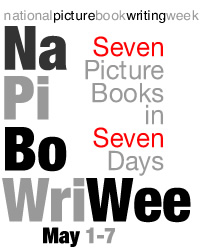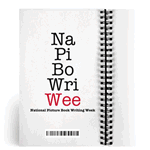NaPiBoWriWee 2011 Day Two – Good Morning!
Good morning! Welcome to Day Two of the 2011 National Picture Book Writing Event extravaganza! Can you believe you survived Day One? Can you believe that you actually wrote AN ENTIRE PICTURE BOOK DRAFT? (And for those of you that didn’t finish, don’t despair! We still celebrate your amazing efforts! Keep going and don’t lose the faith! :))
Yesterday, I wrote about “vomit drafts” and cited some inspirational passages from Ann Lamott’s famous BIRD BY BIRD writing how-to memoir.
Today, we’re going to talk about PLOT! Ah ha… the plot thickens! 🙂
(Keep reading for the rest of today’s Good Morning blog updates after the jump…)
Let’s start with a very helpful description of what a picture book should be comprised of from The Writer’s Guide to Crafting Stories for Children by Nancy Lamb (Writers Digest Books 2001)…
“From ABC to YA: An Overview” (pp. 22-25)
PICTURE BOOKS (ages 3-6 and 4-8)
— Length: 24 book pages (for younger ages 3-6), 32 pages (industry standard), 48 pages (for older children) (manuscript pages: 5 double spaced pages or 1,000 words)
–Simple storylines, straightforward storytelling, rhythm, cadence, repetition.
— How something works or how a problem is solved.
— Hero has a problem, confronts complications, discovers a solution.
######
As a working TV screenwriter, I’ve also learned a lot about the traditional three-act structure that is the backbone of most movies (as well as novels and TV shows etc.). When I started writing picture books, I tried to use this structure as well when I brainstormed ideas. I found it really worked!
(NOTE: If you want to check out the original source of the three-act structure, check out Aristotle’s Poetics in which he lays out the three acts. I don’t expect you to study Aristotle this early in the morning – LOL! But if you are curious, you can find out more here: http://classics.mit.edu/Aristotle/poetics.html)
My own personal breakdown of the three-act structure can be summed up this way:
ACT ONE
– Meet main character
– What he/she wants (goal/desire)
– What’s the obstacle standing in his/her way
– Plot Point #1 – changes his/her life forever and propels them into Act 2
ACT TWO
– Complications ensue (rising stakes – think about all the things that went wrong on the Titanic – now raise the stakes just as high in your storyline)
– Plot Point #2 – Raises stakes even higher, new conflict leads to Act 3
ACT THREE
– Character overcomes obstacle
– Character may or may not achieve desire/goal but discovers what he/she REALLY wants
– “Big Gloom” (all seems lost, darkest moment)
– “Mano a mano” (the final and ultimate confrontation between protagonist & antagonist)
– Resolution!
For more info on plot, definitely check out some of the writing books I recommended in a previous blog. Link is here: https://paulayoo.com/napi/?p=43
######
Finally, below are some tidbits of advice from some of my writer friends about plot. I posted these quotes in a 2010 NaPiBoWriWee blog, but I figured since there are so many new people joining, it couldn’t hurt to include this advice again. Enjoy!
PERSONAL ADVICE FROM WRITER FRIENDS
— From LIN OLIVER, president and founder of Society for Children’s Book Writers & Illustrators. Website: http://www.linoliverproductions.com/
“Hi Paula. Richard Peck always says: ‘Your first chapter is your last chapter in disguise. Write it last.’ I love that.”
— From LISA WHEELER, picture book author. Website: http://lisawheelerbooks.com/
“One of the things I tell the people who take my Picture Book Boot Camp is that plot in a picture book has to be fairly simple. For instance,
1. character wants something
2. character tries to get it 3
3. fails
4. fails
5. fails (rule-of-threes)
6. succeeds,
7. the end.
“In a novel, the plot can be layered and have all these twists and turns and multiple characters, but in a picture book, we try to capture a moment in time—one plot point. Whether it is an hour, a day, a week, or a month—it is all about that same singular plot point. So, even though you have a great story like Carolyn Crimi’s The Louds Move In, which takes place over months of time, the entire plot point revolves around that fact that the family is too loud for their neighbors. Keep it simple. Keep it tight.”
— From KELLY DIPUCCHIO, picture book author. Website: http://kellydipucchio.com/
“For me, plot is pretty much synonymous with ‘problem.’ The problem drives the plot.
“I remember coming across a funny story template for picture books and it went something like—
Once upon a time.
Suddenly.
Luckily!
Happily Ever After.
“I always say picture books are about One True Thing. All the details, all the action, must support that one true thing. There are no sub plots in picture books unless an illustrator adds them in her text (like the prince and princess dancing in Lisa Wheeler’s Boogie Knights).
“Also, I’ve found that if a picture book isn’t working, often it’s because the author has taken a wrong turn somewhere. I look at the very first paragraph of the story to see what question is raised. Then I read the last paragraph to see if that question has been answered. Sort of like what Lin is talking about with her first chapter, last chapter thing.”
######
Well, that’s it for your NaPiBoWriWee Day Two “Good Morning” blog! Now I’m off to my work and writing batcave. I’ve got a full day of work at my job as Producer on SyFy’s EUREKA followed by trying to write Book No. 2 tonight as well as keep up with the blogs. Stay tuned for Day Two’s Special Guest Author blog which will be posted at 5 PM (PST). Until then…
Happy Writing! WRITE LIKE YOU MEAN IT! 🙂


Always good to be reminded about the 3-act structure.
Have a great writing day, everyone!
This is a great post. I’m going to post a link to it on my writer’s blog.
Sometimes I feel like a novice 😛
Wonderful post. I’d forgotten about the three-act structure. Thanks for the reminder. 🙂
That’s the approach I take. It helps to have some idea of the structure to keep it all moving. Even more helpful in these vomit drafts.
Thanks for a very helpful post! It’s been a long time since I studied how to write PBs, so I’m pretty much just winging it for NaPiBoWriWee on what little I remember. This helped to refresh my memory.
More photos of Oreo and your other kitties, please! They help inspire me…yeah, really! 😉
Catching up on comments! Tnx! Stay tuned for more cat pics. Mmmmwahahah! 🙂
Happy Day Two, Writers! I’m lovin’ these tips and the term “vomit draft” (a much better word than “junk”) 🙂 I just cranked out my second draft. I’m feeling a bit wary… both my day 1 and day 2 drafts came lightning quick to me… and these were ideas I didn’t have anything brainstormed ahead of time. Something makes me think that the couple of ideas that I DO have notes on will be harder to write… I’m having fun, though! ~Jen
Hey Jen! Glad u r zipping along in your writing. Some ideas are easier to write than others. Fingers crossed you have more lightning days. 🙂
Thanks for posting this. Plot is my weakness!
Catching up on comments! You’re welcome. BTW character = plot too, so if you are having story idea problems, think about your character’s personality and desires. That often can jumpstart the ideas! 🙂
I wrote my draft #2 and forgot to let you know. 🙁